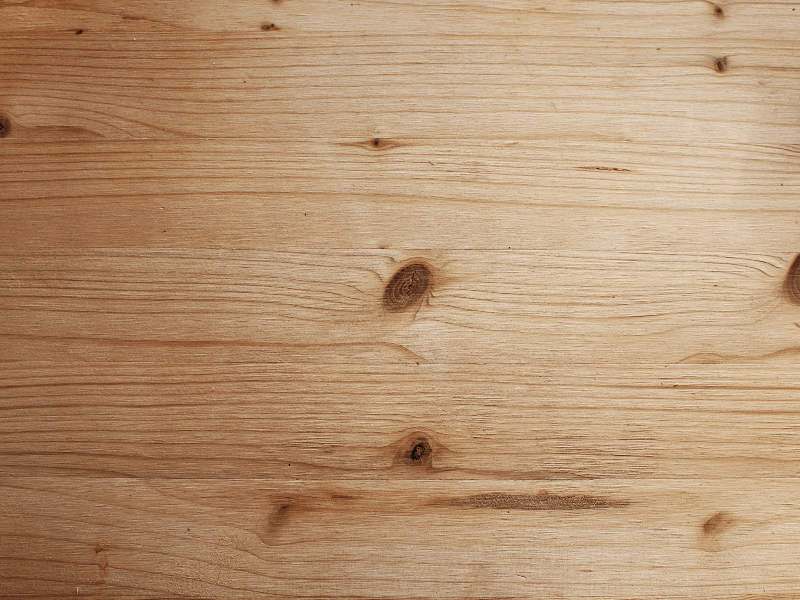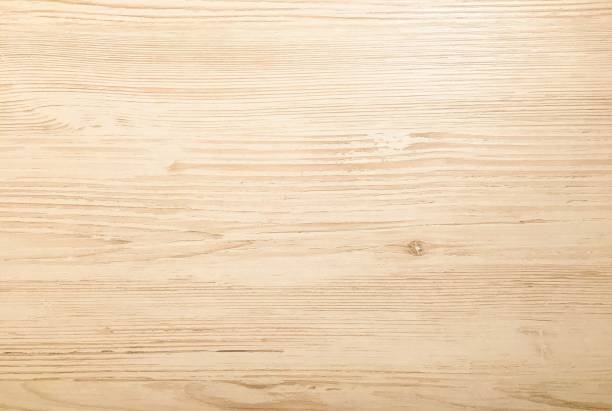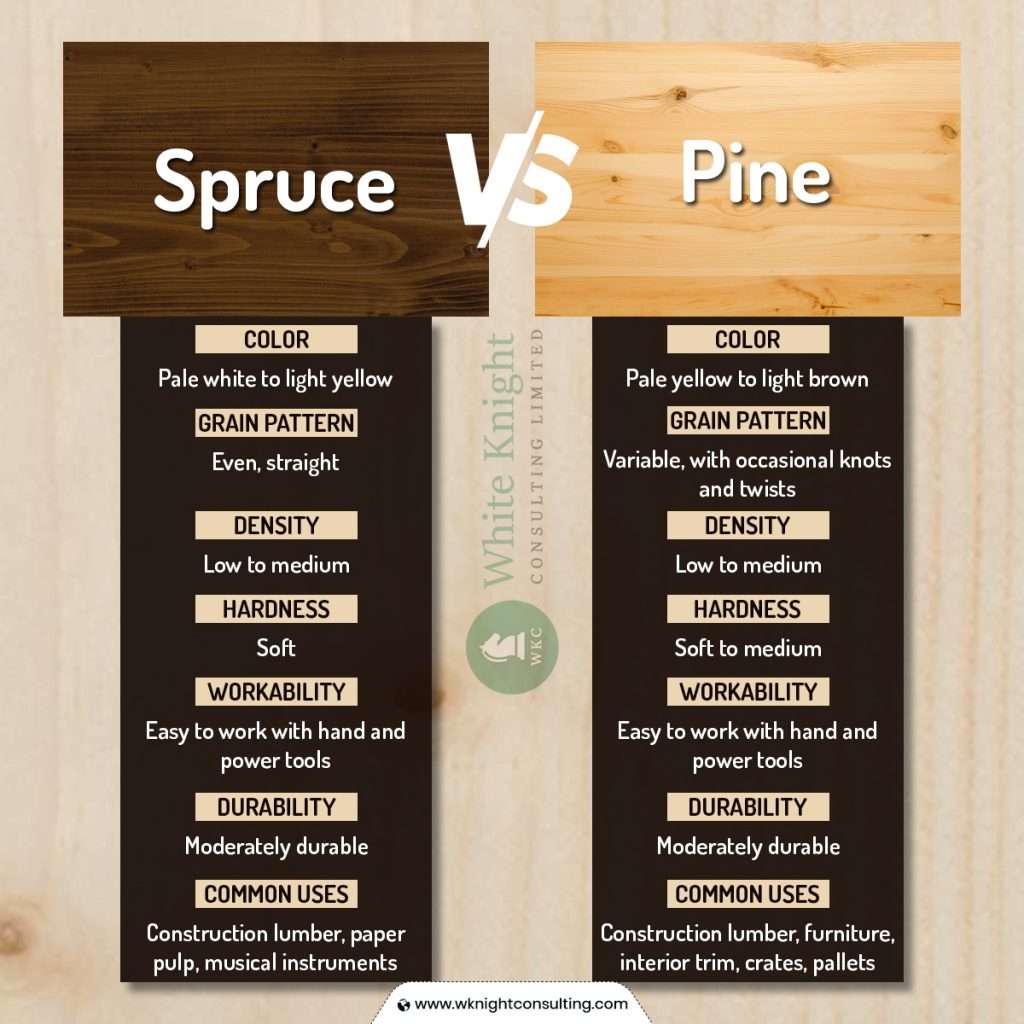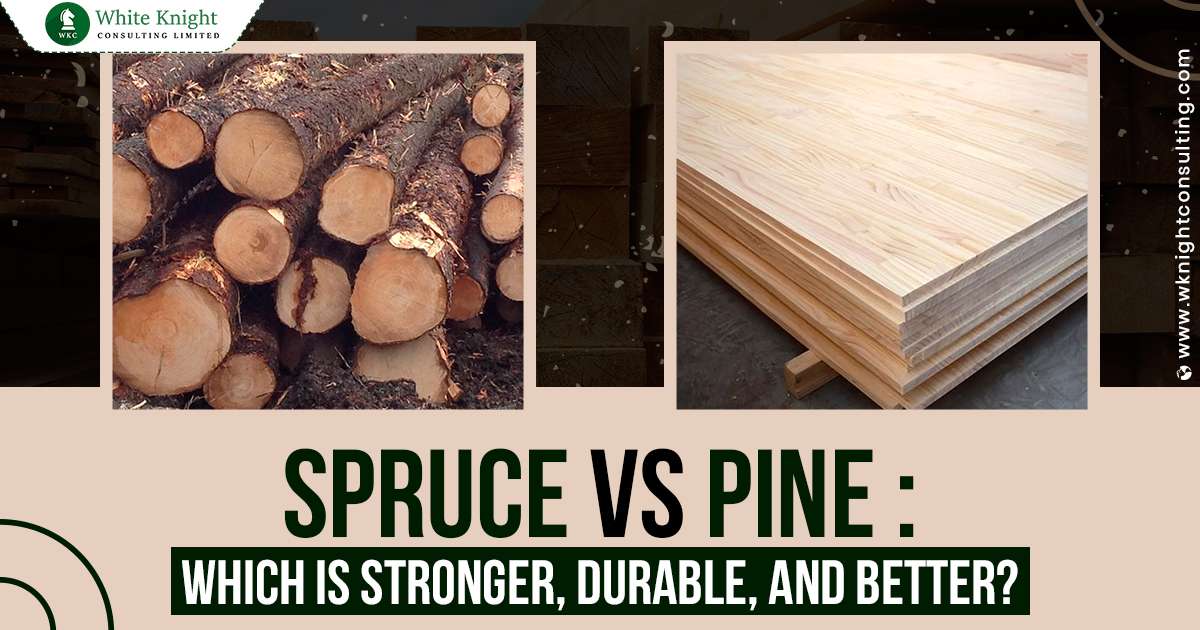Both spruce and pine lumber are softwoods that are obtained from conifer trees. There are many differences between spruce and pine, from their origin and trees to their structure, appearance and various uses.
Whether you are looking to know more about spruce or pine wood or want to get detailed knowledge of the differences between the two, here’s everything you need to know about spruce vs pine.
What is Softwood?
Softwood is a type of wood that is obtained from conifer trees, i.e. trees that have cones instead of leaves and are evergreen.
Softwoods are comparatively softer than hardwoods. They are less durable but also less expensive and fairly easy to work with. Softwoods are more easily and widely available than many hardwoods and are considered versatile enough to be used across a wide range of applications.
Pine and Spruce lumber are two very popular examples of softwood.
What is Pine?

Pine is a softwood that is obtained from a conifer tree with long needles or cones. Pine is one of the most popular softwoods in the world because contrary to its genre (softwood), pine is actually considerably hard and strong (hard pine) and quite durable and is used in many applications.
Pine wood comes in many varieties or species, all of which can be broadly categorised as either hard pine or soft pine.
Hard pine can be divided into Southern Yellow Pines, Western Yellow Pines, Pinyon Pines and Red Pines. Popular species of hard pine include shortleaf, longleaf and loblolly pine and are comparatively harder than soft pine species, which include Eastern white pine, Western white pine and sugar pine.
Yellow pine species are amongst the hardest types of pine and are even harder and stronger than some hardwood species.
Soft pine species are widely spread and easily available and are similar to spruce wood in terms of properties.
What is Spruce?

Spruce is another popular softwood timber. It is a very soft and lightweight wood with medium density. There are many species of spruce softwood, of which Norway spruce, black spruce, red spruce, and white spruce are the most popular ones.
Needles in a spruce tree are sharply pointed and with four sides. They are stiff and will break easily when bent.
The spruce timber is soft and creamy-white and is known for its tonal quality, which makes it suitable for use in musical instruments. Spruce is also commonly used for pulpwood, interior trim, construction, and fences. The shoots or sprouts of spruce wood are considered a wonderful source of Vitamin C.
Spruce vs Pine : Similarities
Because both spruce and pine are structural softwoods and obtained from conifer trees, they share many similarities, such as:
Both pine and spruce wood are considered equally suitable for applications requiring the use of softwood timber. The two kinds of wood are closely related in terms of resilience and uses.
Both pine and spruce lumber belong to the family Pinaceae. Both trees have thin leaves called needles. Both trees also have cones. The top of both trees has pyramid-shaped crowns.
Both spruce and pine trees are used as Christmas trees and pulpwood (paper).
Spruce Vs Pine : Differences

Spruce and pine wood share many properties with each other but are also very different in terms of uses and properties. Here’s everything you need to know about the difference between spruce and pine.
Because hard pines are quite hard and stronger than your average softwood, they are not generally compared with spruce. However, soft pines are nearly the same as spruce and other softwood species in terms of strength and hardness.
Spurce vs Pine
Technical Specifications:
| Variable | Spruce | Pine |
|---|---|---|
| Average Dried Weight | 0.45 – 0.57 g/cm³ | 0.35 – 0.53 g/cm³ |
| Specific Gravity | 0.45 – 0.57 | 0.35 – 0.53 |
| Janka Hardness | 350 – 630 lbf | 380 – 870 lbf |
| Modulus of Rupture | 6,500 – 10,600 psi | 7,800 – 14,500 psi |
| Elastic Modulus | 1.2 – 1.6 Mpsi | 1.1 – 1.6 Mpsi |
| Crushing Strength | 3,100 – 5,500 psi | 4,200 – 6,500 psi |
| Shrinkage | Radial: 3-7%, Tangential: 8-13%, Volumetric: 11-20% | Radial: 2-5%, Tangential: 5-10%, Volumetric: 9-18% |
Appearance
Colour: Pine has a rustic appearance and is darker in colour. Its heartwood colour ranges from yellow to brownish-red while the sapwood is pale white. Alternativerly, spruce is very light-coloured, creamy white or almost white, sometimes with a yellowish or red hue.
Grain & Texture: Pine exhibits a straight grain with an even texture, whereas spruce showcases a fine, even texture and straight grain. It is worth noting that spruce may occasionally feature small knots on its surface, whereas the knots on pine are more prominent & less uniform compared to spruce.
Physical Properties
Origin & Trees
Norway spruce is found in Northern and central Europe. Eastern white pine mainly comes from Eastern North America, but other species of pine are grown all over the world.
Both spruce and pine trees are called conifers because they have cones instead of leaves and are evergreen trees. The needles of pine are longer than the needles in a spruce tree. While each twig of spruce has a single needle, pine has around two to five needles per twig. The needles in a pine tree are soft, thin and flexible and will not break when bent, unlike spruce tree needles which are stiff and easily break when bent.
While there are around 35 species of spruce, pine has over 175 species.
Spruce trees are 115-180 ft (35-55 m) tall and have a 3-5 ft (1-1.5 m) trunk diameter. Pine trees are generally 65-100 ft (20-30 m) tall with a 2-4 ft (.6-1.2 m) trunk diameter, but there are also present much older and taller pine trees.
Spruce trees are full of branches that are upturned and give the tree a pyramid-shaped look. Pine trees have fewer, spirally-arranged branches.
Spruce wood has a rough bark which becomes wrinkled with age. The bark of pine is smooth at a young age and becomes darker and rough with age.
Strength & Durability
In terms of hardness, many varieties of hard pine are absolute winners with the Janka hardness rating going over 1,200 lbf for some species. However, the average hardness rating of more economical soft pine species is about 400 lbf, which is almost the same as the hardness of spruce (~380 lbf).
Because of its exceptional strength-to-weight ratio, spruce wood is preferred for making musical instruments such as guitars and violins.
The weights of spruce and pine wood are practically the same. In the case of Norway spruce, the average dried weight is around 405 kg/m3, while the average weight of White Pine is 400 kg/m3.
Pine is moderately durable with a slight resistance to decay. It can be attacked by insects. The heartwood of spruce is almost non-resistant to decay.
Though the timber of pine is less strong than spruce wood, it is more durable due to the high amounts of resin present in pinewood.
Workability, Availability & Price
Workability
As a soft softwood, spruce is generally easy to work with. Knots can, however, sometimes cause problems when working with machines. It glues and finishes well. It has very few pores, which can make spruce difficult to stain. Staining without a sanding sealer or toner might result in blotches. Norway Spruce has been reported to sometimes cause skin allergies and asthma-like problems in some workers.
Almost all species of pine are fairly easy to work with both hands and tools. Even the hardest type of pine is easy to cut using machine tools. It also glues and finishes well and is easy to paint. Some species of pine have a resinous odour. Working with pine is also known to cause skin allergies or asthma issues in some cases.
Spruce is less likely to warp or twist over time. It is also easily available in long, straight pieces, which makes it perfect for exclusive applications such as fencing.
Availability & Price
Pine wood is cheaper than Spruce and easily available. White pine is mainly harvested and imported for construction timber. It is moderately priced in areas where it is locally produced.
Most of the spruce harvested globally is meant for construction and is easy and inexpensive to buy. Instrument-grade spruce, which is used for making musical instruments and other speciality items, such as German Spruce and Yugoslavian Spruce can be more expensive.
Uses of Spruce and Pine
1. Structural applications: Both pine and spruce are considered suitable for all structural applications, including beams, structs, studs, frames, and braces. Spruce is sometimes preferred in some structural uses because of its higher strength-to-weight ratio.
2. Visual applications: For projects such as open structures and beams where the aesthetic appeal of the wood is a concern, pine is often favoured over spruce because of its unique darker and more attractive appearance.
3. Fencing: Between pine and spruce, the latter is more suitable for fencing because it doesn’t warp or twist easily. Also, long, straight panels of spruce are easily available.
4. Interior applications: For interior applications such as trim, windows, doors, cabinets, etc, both pine and spruce are considered equally great because of their straight grain. Spruce is, however, sometimes used more because it contains fewer knots.
5. Furniture: Both spruce and pine are practically the same in properties, but pine is favoured for furniture because it looks more attractive and is easy to finish and/or paint. Pine is used for all kinds of furniture, cabinets, shelves, window frames & more. Neither is, however, suitable for outdoor furniture.
6. Flooring: Both pine and spruce can be used for flooring in less-corded places such as rooms, but they will catch dents and scratches easily. Softwoods are used for flooring only because they are cheaper than hardwoods. Pine is the favourite here because it is somewhat more durable than spruce and the darker hue can better hide dents.
7. Christmas trees: Though both pine and spruce are used for Christmas trees, spruce is favoured over pine because of its pyramid-shaped crown that is very symmetrical.
Pine uses: Pine is used for making crates, boxes, paper, interior millwork, furniture, carving, and boatbuilding.
Spruce uses: Other uses of spruce include construction, millwork, crates, boxes, paper, and musical instruments.
Where to Buy Pine & Spruce Softwoods?
Pine and spruce lumber are two of the most popular softwood species that are found and used all over the world. In the UK, we use both imported and locally-harvested softwoods. The price of pine and spruce wood in the UK is cheap and both species are easily available country-wide.
If you are looking to buy Pine or Spruce construction timber at the best price in the UK, contact White Knight Consulting Ltd for the best deal. We are a leading manufacturer and wholesaler of sustainably-sourced, high-quality timber with doorstep delivery in all parts of the UK. Contact us for a free quote now.
